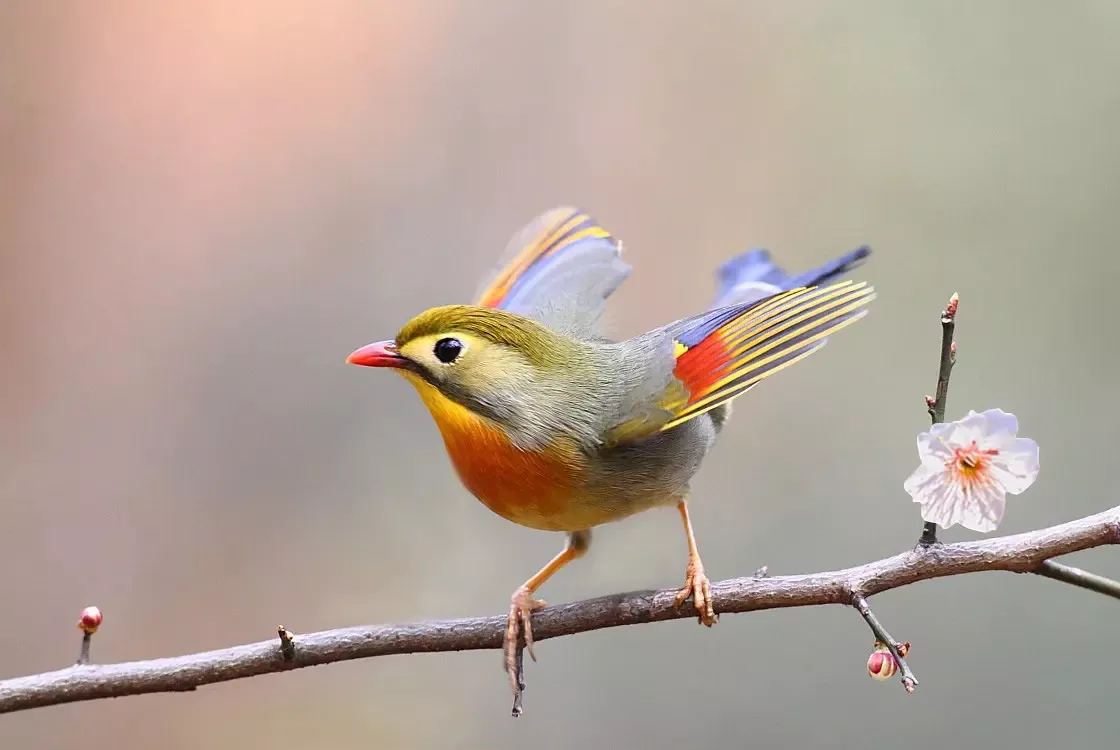The Red-billed leiothrix (Leiothrix lutea) is a member of the family Leiothrichidae, native to southern China and the Himalayas. Adults have bright red bills and a dull yellow ring around their eyes. Their backs are dull olive green, and they have a bright yellow-orange throat with a yellow chin; females are somewhat duller than males, and juveniles have black bills.
What does red-billed leiothrix look like?
The male bird of The red billed leiothrix has olive green on the forehead, top of the head, pillow and upper back stained with yellow, the forehead and the front of the top of the head are slightly lighter, the lower back, waist and tail coverts are dark gray olive green, and the longest tail coverts are light Yellow end spots. The tail is forked and bright black, the outer tail feathers are slightly curved outwards, the central tail feathers are dark gray olive green with metallic blue-black end spots, the outer tail feathers and end spots are metallic blue-green, and the base of the inner tail feathers is dark gray olive green. The wing coverts are also mostly dark olive green, and the flight feathers are dark brown, gradually deepening inward, and are bright black. The outer edge of the primary flight feathers is yellow, and gradually turns golden yellow inwards. From the third primary flight feathers, the base of the primary flight feathers is vermilion, forming conspicuous vermilion wing spots; the outer feathers of the secondary flight feathers are bright Black, orange-yellow base. The eyes and around the eyes are light yellow, the ear feathers are light gray or olive gray, the chin and throat are bright yellow, the upper chest is orange-red, forming a prominent chest band, the lower chest, abdomen and undertail coverts are yellowish-white or creamy yellow, the abdomen The middle part is whiter, the flanks are olive-green gray or light yellow-gray; the underwing coverts are gray, and the axillary feathers are yellow-green stained with gray.
The female and male are roughly similar, but the vermilion on the wing spots is replaced by orange-yellow, and the eyes are white and slightly yellow.
Iris dark brown or light reddish brown, mouth reddish red, base black, tarsus and toes yellowish brown.
Red-billed leiothrix habitat
It mainly inhabits mountainous evergreen broad-leaved forests, evergreen deciduous mixed forests, bamboo forests, and forest margins at an altitude of 1200-2800 meters. In winter, it often descends to low mountains, foothills, plains and river valleys below 1000 meters above sea level. , and sometimes into the bushes near cottages, gardens and farmland.
Red-billed leiothrix living habits
- Migration: Resident birds.
- Habits: In addition to being active in pairs or alone during the breeding period, it usually forms small flocks of 3-5 or more than 10 in other seasons, and sometimes moves in mixed groups with other birds. It is bold in nature and not very afraid of people. It often shuttles, jumps, and flies between trees or undergrowth, and occasionally moves and looks for food on the ground. Good at singing, especially during the breeding period, the singing is loud and melodious.
- Tweeting: It often stands on the top branch of the shrub and sings loudly, and constantly shakes its wings. The male bird often flaps its wings and erects its body feathers when singing. The sound is crisp and loud, changeable and melodious, while the female bird can only make a low and single sound.
- Food: It mainly feeds on insects such as caterpillars, beetles, and ants. It also eats plant foods such as plant fruits and seeds, and occasionally eats a small amount of crops such as corn.
Distribution range of Red-billed leiothrix
It is mainly distributed in Bhutan, China, India, Myanmar, Nepal, Pakistan and Vietnam.
Mode of reproduction
The breeding season is from May to July. Nests are usually built in the undergrowth or forest edge bushes or bamboo bushes, and the nests are mostly built on the side branches of shrubs or small tree branches or bamboo branches, 1-1.5 meters above the ground. It is in the shape of a deep cup, mainly composed of moss, grass stems, grass leaves, leaves, bamboo leaves, bark, grass roots and other materials, and is lined with thin grass stems, palm silk and fibrous roots. The size of the nest is 8-12.6 cm in outer diameter, 5-8 cm in inner diameter, 6-8 cm high, and 5-6 cm deep. Each clutch lays 3-4 eggs, the eggs are white or greenish white, covered with ocher or lavender spots, especially the blunt ends are denser, the size of the eggs is 20.2-24.3mm×16.2-16.4mm, and the weight is 2.4-3.0g .


 Facebook
Facebook  Instagram
Instagram  Youtube
Youtube 